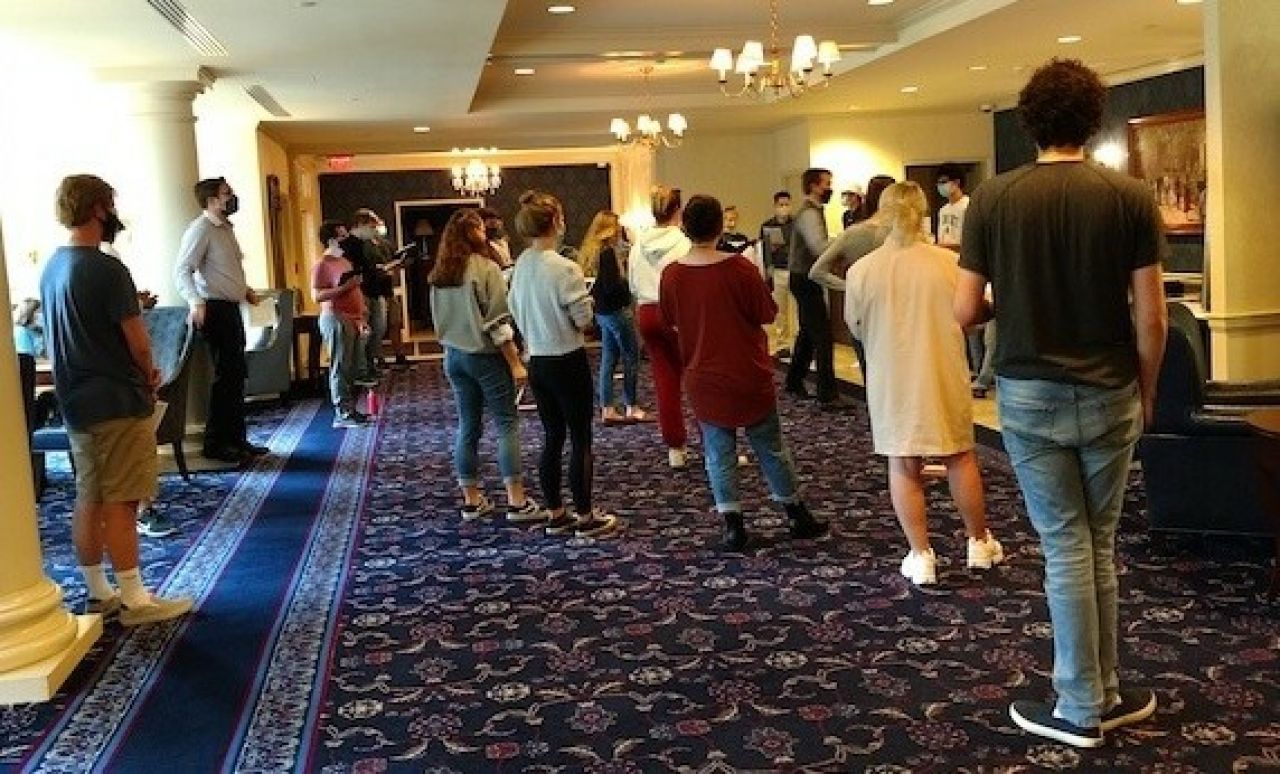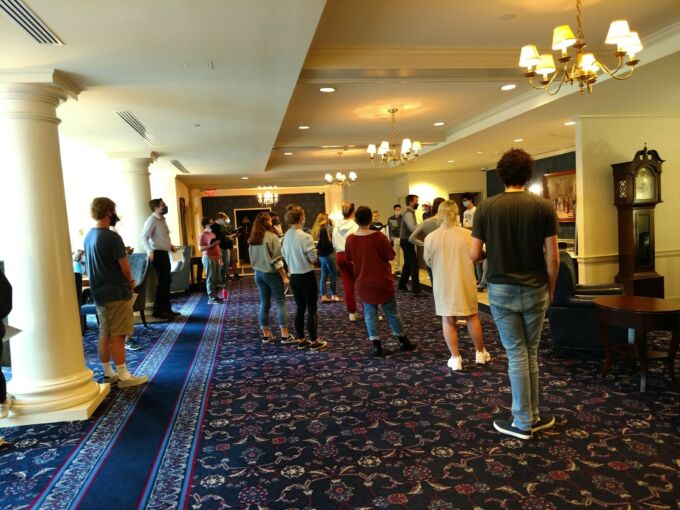November 05, 2021
School of Music serves as example for COVID-safe, in-person events

“I could be brown, I could be blue, I could be violet sky, I could be hurtful, I could be purple, I could be anything you like.”
In September, University Choir members could be heard singing that TikTok-famous refrain (from the 2007 song “Grace Kelly” by Mika) inside the Nittany Lion Inn, where they have been holding COVID-safe rehearsals during the fall 2021 semester. They join the Concert Choir, Glee Club and Oriana Singers in rehearsing at the Inn, whose various large spaces allow the singers to be spaced three feet apart, per current Centers for Disease Control recommendations.
Innovative rehearsal spaces are just one example of how the School of Music is successfully “making music” during the pandemic. This semester marked the return to live, in-person performances, to the delight of performers AND patrons.
“Pure joy is what I see on everyone’s face—through a mask, of course!” said Russell Bloom, assistant director for operations and outreach in the School of Music. “Wide eyes sometimes flooded with tears drift around the recital hall, taking it all in. There is stillness in the audience."
The audience sits so attentively, as if to make sure they don’t miss a moment in case it goes away again.” - Russell BloomPieter Ouwehand, who with his wife, Lida, is a longtime patron and supporter of the School of Music, agreed, adding he greatly appreciates the opportunity to attend events in-person again. “We are delighted to attend live events at the School of Music where we are able to meet fellow music lovers, students and musicians. A live music event beats a Zoom performance any time,” he noted. The last in-person performances in the School of Music were in early March 2020. When Penn State shifted to remote operations in mid-March of that year, administrators, faculty and staff from the school jumped into action, knowing they had to figure out how they could continue to teach and learn in the midst of a highly contagious, airborne virus that was made even more transmissible through singing and instrument-playing. From the start, their decision-making process was steered by scientific, peer-reviewed research. The most current research regarding aerosol transmission has guided the school’s return to in-person performances, and while the experience may be a bit different for patrons than what they are used to, Bloom said that, overall, audiences have been understanding and accommodating. “We do our best to help the patrons understand the science backing our decisions and that it could and sometimes does change between their visits,” he explained. Protocols include masking for all singers, percussionists and string players; at least three feet of spacing between performers; “airing out” of performance spaces for performances longer than 45 minutes (all performers and audience members leave the space); and, per Penn State policy, masking for all audience members when inside University buildings. Wind and brass players lower their masks when playing. According to Bryan Nichols, assistant professor of music education and director of the University Choir, the students are grateful to be able to not only rehearse together, but also perform for live audiences. Last year they rehearsed in person—but spaced 10 feet apart in locations such as Eisenhower Auditorium—and did livestreamed performances. “It is easier to rehearse and perform together when we are actually together—close to the performers around us, that is. Now it’s three feet, and it makes an enormous difference in terms of being able to hear the singers in your section and the singers in other sections,” he said. Christopher Kiver, professor of music and director of choral activities, echoed Nichols’ comments. “Students have had to learn to be resilient and flexible,” he said. “I am grateful to the students and faculty for being more innovative in our recruitment efforts in the late summer in an effort to return choir member numbers to pre-pandemic levels."
I am also grateful to my choral colleagues for persevering in the face of numerous challenges, providing a positive experience for students.” - Christopher KiverInstrumentalists are also persevering while facing some different challenges from vocalists. After wearing special masks with slits last year, currently brass and wind players wear regular masks but pull them down when playing, in accordance with the latest research that shows playing with a slitted mask does little to reduce bio-aerosol transmission. Most instrumental performances take place in the 420-seat School of Music Recital Hall, which allows ample space for both performers and audience members. After a hiatus in 2020-21, the Recital Hall is once again buzzing with activity. The atrium outside the hall provides an ideal space for audience members to mingle (or distance themselves) during concert intermissions. As part of the School of Music’s protocols, everyone must leave the hall during intermission, when portable air filters are used to help “air out” the space. As pandemic conditions shift, performance conditions may change as well. Bloom said the School of Music community—including patrons—has been understanding and appreciative of the protocols in place. “The audience is a critical member of our performance,” said Bloom. “Performing to an empty hall in front of a camera is not easy. When you have a partner in the room to respond to, both souls are nourished.” For a full schedule of events in the School of Music and College of Arts and Architecture, visit https://arts.psu.edu/events/.

